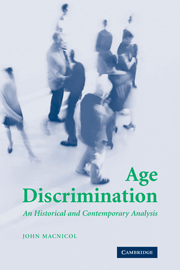Book contents
- Frontmatter
- Contents
- List of figures
- List of tables
- Acknowledgements
- Part I Ageism and Age Discrimination
- Part II The Current Revival of Interest in Britain
- Part III Retirement, health status and work-disability
- 4 Health status and old age
- 5 From the late nineteenth century to the 1940s
- 6 The 1950s and 1960s in Britain
- 7 The recent debate
- Part IV America's Age Discrimination in Employment Act
- Bibliography
- Index
6 - The 1950s and 1960s in Britain
Published online by Cambridge University Press: 24 August 2009
- Frontmatter
- Contents
- List of figures
- List of tables
- Acknowledgements
- Part I Ageism and Age Discrimination
- Part II The Current Revival of Interest in Britain
- Part III Retirement, health status and work-disability
- 4 Health status and old age
- 5 From the late nineteenth century to the 1940s
- 6 The 1950s and 1960s in Britain
- 7 The recent debate
- Part IV America's Age Discrimination in Employment Act
- Bibliography
- Index
Summary
Introduction
The twenty years after the end of the Second World War witnessed in both Britain and America a lively and detailed debate on old age. In Britain, the first modern social surveys explicitly on old age were published; geriatric medicine took off with the establishment of the National Health Service; state pensions continued to be a major fiscal and political issue; there were serious concerns over retirement, population ageing and future ‘dependency ratios’; and in a way that was uncannily similar to the 1990s, British governments made concerted attempts – ultimately unsuccessful – to persuade older workers to remain longer in work. As two contemporaries observed, the problems of old age were suddenly discovered in the 1940s and 1950s, after a period of relative neglect. In some ways, this concern was odd, given that the 1950s were years of relative full employment and economic growth. However, we should be wary of the benefits of hindsight: Britain had only recently emerged from all the disruptions and privations of the Second World War, preceded by two decades of major recession, and in the late 1940s it was a society struggling to adjust to peacetime economic conditions.
The British economy of the 1950s was one in which manual working-class jobs were steadily declining and new, service-based jobs were expanding. Many of these service-based sectors were experiencing labour shortages: as is well known, the National Health Service and London Transport had to recruit workers from New Commonwealth countries to fill vacant jobs.
- Type
- Chapter
- Information
- Age DiscriminationAn Historical and Contemporary Analysis, pp. 151 - 176Publisher: Cambridge University PressPrint publication year: 2006



